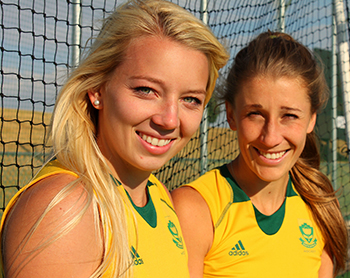
Nicole Walraven and Liné Malan
Photo: Hatsu Mphatsoe |
Three of the star players of Kovsies Hockey formed part of the South African Women’s Hockey team, which competed at the Hockey World League (HWL) tournament in Spain.
Hatsu Mphatsoe, student assistant at the Department of Communication and Brand Management, spoke to Nicole Walraven and Liné Malan. Tanya Britz will be returning only at a later stage to South Africa.
As key players in the Kovsies women’s team, Malan and Walraven (along with Britz) have a new wealth of knowledge that could assist the team in their forthcoming USSA tournament. Here are some of the sentiments they had to share:
What was your reaction when you first received the news that you’d be representing the country in Spain?
Liné: “It was a shock to me, I honestly didn’t expect it. At the same time, I was extremely excited to be granted the opportunity to represent my country, and prove my worth to the team.”
Nicole: “I was so excited and felt honoured! To represent my country at such a big tournament is amazing. I was very nervous, but excited.”
How has playing at an international level improved your personal performance and mentality of the game/sport?
Nicole: “Playing at such a high level has helped my hockey immensely. It has helped me read the game better, it has upped my self-confidence, and it has also improved my ability to deal with pressure.”
Liné: “Playing at an international level looks much easier than it is. It is a much faster game, the pressure on the ball is much higher, and the individual skills are on a different level. It has helped me to lift my game, and make decisions much quicker. It has honestly benefitted me as an individual, and I’ve learnt so much from the experience.”
Now that you’ll be going to play at the USSA tournament, what new perspectives do you wish to bring to the team in order to improve its overall performance there?
Nicole: “The importance of teamwork as well as adapting the game plan according to the situation and the opposition. Constant hard work and a never-give-up attitude are vital. One quote that stood out from the tournament is ‘1MT, 1MT’ which stands for ‘1 More Thing, 1 More Time’.
Liné: “Going to USSA, I now have a better understanding of what pressure is, and how to make better decisions. We will still make use of our Kovsies brand of Hockey, which is our passing game, and apply all aspects to the best of our ability.”